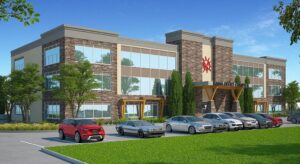Chippewas of Rama First Nation to expand community health and social services

By Colin Graf
CHIPPEWAS OF RAMA FIRST NATION — Members of Chippewas of Rama First Nation will soon be able to get medical help and access to other services more easily, comfortably, and in greater privacy as the new health and social services building gets closer to completion.
The new three-floor building with 12,000 sq. ft. of space, each for health and social services, will bring together workers currently scattered in different locations, allowing them to better serve residents, says Chief Ted Williams. Mnoyaawgamig, or Place of Well-Being, should be open by Dec. 1, Chief Williams hopes.
Bringing the services under the same roof will make it easier for staff to work together and expand their services to help community members’ overall health issues, says Leanne McRae-Douglas, Director of Health & Social Services. The two departments have been in separate buildings and bringing them together will “streamline our services,” and give workers “the ability to collaborate to provide a more integrated approach to wellness.”
When a nurse and an addiction worker can meet together quickly and easily to discuss how best to help a patient, it can lead to better service for those in need, she offers as an example.
Staff are excited about the move and “we are excited for them,” says Chief Williams.
“From a team-building perspective, it’s always good to know what’s happening in the left hand and what’s happening in the right hand,” he says.
Privacy for people seeking help from social workers will be improved as the social services building currently has only fabric curtains between meeting areas. Extra space in the new building will mean more than one program to run each day, McRae-Douglas explains.
More space on the medical floor will allow for visiting professionals such as psychotherapists and traditional healers, who will have more of a focus on intergenerational trauma.
“We want it to be a safe and welcoming place for people to be able to come and connect to services…and look on it as a place of wellness, not a place of illness,” she says.
The medical floor will have six clinic rooms for nursing care and six more rooms for other visiting professionals including family doctors, a chiropodist, and a massage therapist. Social services will have a large space for play therapy and other children’s programs, another room for family and group meetings, and a third for arts and crafts. At present, the health centre has only three clinic rooms, and social services have room for three visiting specialists and “very little” programming space, the Director says.
A new training kitchen will allow patients with diabetes or obesity to learn about foods that can help their conditions. Another program being planned in the new building is learning about traditional medicines, McRae-Douglas says.
Providing all of these services from one location will “ensure our members have access to integrated and coordinated support services to enhance their holistic well-being, not just their physical, but also their mental, emotional, and spiritual wellbeing as well,” she adds.
According to Chief Williams, the ground floor of the building will be leased out to other tenants. Out of 12 units, seven are already spoken for and they do not expect any challenges to fill the remaining spaces.
One will be a locally-based food outlet, some have been leased by health professionals, and another is “a large Canadian entity that is well-known across the country providing professional services to the Indigenous community,” Chief Williams describes.
Many community members have graduated from post-secondary education in professional programs and are “slowly migrating back home to Rama, creating a demand for office space,” he says. The tax benefits of earning income on First Nations land is “a big driving factor,” for the new tenants, he adds.
Rama’s location, 1.5 hours north of Pearson, with Casino Rama nearby, are also attractive factors for possible tenants looking to relocate, according to the Chief.
The closure of the Casino since the COVID-19 pandemic hit in Mar. 2020 has hurt the community with the loss of employment and patronage for local businesses, Chief Williams says; however, the First Nation has continued to receive lease payments under the terms of the funding agreement between the community, province, and casino operator.
“The decrease in traffic obviously doesn’t help matters, [but] we kept the community safe [from COVID-19],” says Chief Williams, noting only five cases of COVID-19 were reported last fall and none since.
Step 3 of the provincial reopening plan allows for casinos to open their doors, and while Chief Williams expects an announcement very soon, he has told the province and the company re-opening will be the decision of the community leadership.
“[It] is not at the whim of the province at all. It will be called by us, the Chief and Council of the community, because this is our community; it’s the health of our people and we will be the ones making the call whether or not the casino opens and when it opens.”

